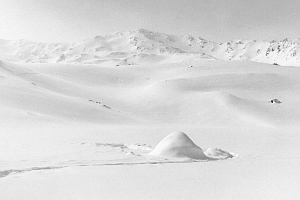| Etching Expedition to the Stubaier Alps, Austria in March/April 2005 | ||
In winter 2005, I travelled with ca. 200 kg of luggage, including 40 kg of zincplates, to the Stubai Alps/Austria. I lived by myself in a home-made snowcabin in the Fortschervalley, close to Innsbruck in 1,900 m above sealevel.
|
After two weeks of exceeding low temperatures (at night -25°C) I constructed a small igloo, which served as a bedroom and provided significantly higher temperatures. In these six weeks of my totally autarkic way of living I created ten drypoint processes. The daily-luggage I trailed in a sleigh, but ahead of steepstages I often had to leave it behind. Therefore, on my way back, I had evenmore fun with my sleigh. To some extent, the wandering-tours to the motives took serveral hours. For moving, I used snow-shoes, which enabled me to reach isolated places during my search for motives. As soon as the sun started shining, the snow cabin shrinked on the joint of the wood and the rocks. Hence, I shovelled a path around the rocks, from which I could extend the walls and the roof. |
|
Extract from my diary, March 7 2005: For three weeks I have been living in the igloo and I scratched four zincplates. Today, I have half-time of my whole Etching Expedition. My greatest worry, to become mad or depressive, didn′t come true, luckily. Innumerable snow-blocs and wood-columns spanned two rocks and provided under the prevailing circumstances a generous living room with kitchen, lit up by an ice-window, a seat to keep the diary as well as storage space for the expedition material and the zincplates. Thus, I could escape from a mouse, that was clucked by the waste in the "kitchen". Daily, I sparked a charcoal-fire in front of my snow cabin, for meltings now and for making tea and warm meals. I used, the glow due to a self-constructed charcoal-oven, indoors for heating, as a barbeque grill and for drying my clothes. |
A blanket served as a curtain to separate the living-from the working area. As soon as the sun started shining, the snow cabin shrinked on the joint of the wood and the rocks. Hence, I shovelled a path around the rocks, from which I could extend the walls and the roof. To some extent, the wandering-tours to the motives took serveral hours. For moving, I used snow-shoes, which enabled me to reach isolatet places during my search for motives. In combination with my Diploma 2005, I made a documentary, that presents the whole Alps-project together with the graphic sheets. |
|
Pleinair in Mesolithicum Mathias Wagner / Picture-Gallery "Neue Meister", Public Art Collection Dresden On the tracks of hunter-gatherers of the Stone Age, Konrad Henker discovered the Stubaier Alps in summer 2004. As an assistant of an archaeological excavation, he experienced an ethnic landscape day after day. In the approaching winter, he returned. Neither escape from civilisation, nor the desire for a ruminant eremitage, nor the demand for extreme outdoor activities forced him to the mountains in this season of the year. Nevertheless, his six-week-residence included some what of all this. However, he is not the "Wanderer Above the Sea of Fog", who transforms the experience of nature into speculation about existence. It is the pictures, that the artist already found in summer and that promised to be even more fascinating in winter time. In winter, when snow and ice cover the valleys, meadows and mountainsides and the brumal white contrasts the grey, brown and black of the steep rugged rocks and ridges, the mountains seem to dilate into the cosmic. |
Imbedded into the endless white and outshined by the brilliant blue of the sky, the mountainside obtains monumental features. Distances are not measured, but overpeered. The perspective is loosing every regulative dimension, is just a theoretical option. In this brumal atmosphere, the archaic aura of the high mountains reveals as the result of exceeding geomorphic transformations, which started out thousands of years ago and still last. To expose oneself to this landscape, to feel the infinity and to wrest specific motives from it was the great challenge within these six weeks. To make sure that the directness of this spectacle of nature lasts and to avoid any retrospective transfiguration, the adoption of the etching plate took place on location. The interplay between great light-coloured or little treated and dark, closely subtle dashed parts of the etching - figuratively the tension between emptiness and object and snow and rock, respectively - affects the character of all sheets. They mirror the anticipation of a primeval world as well as human experience and a forgiving reflection. |
|
